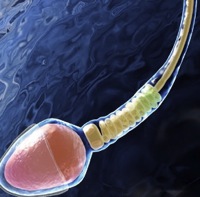Difference between revisions of "Sperm"
m (Text replacement - "http://nordan.daynal.org" to "https://nordan.daynal.org") |
m (Text replacement - "http://" to "https://") |
||
| Line 3: | Line 3: | ||
==Origin== | ==Origin== | ||
[https://nordan.daynal.org/wiki/index.php?title=English#ca._1100-1500_.09THE_MIDDLE_ENGLISH_PERIOD Middle English], from Middle French ''esperme'', ''sperme'', from Late Latin ''spermat''-, ''sperma'', from [[Greek]], [[literally]], [[seed]], from ''speirein'' to [[sow]] | [https://nordan.daynal.org/wiki/index.php?title=English#ca._1100-1500_.09THE_MIDDLE_ENGLISH_PERIOD Middle English], from Middle French ''esperme'', ''sperme'', from Late Latin ''spermat''-, ''sperma'', from [[Greek]], [[literally]], [[seed]], from ''speirein'' to [[sow]] | ||
| − | *[ | + | *[https://en.wikipedia.org/wiki/14th_century 14th Century] |
==Defiinitions== | ==Defiinitions== | ||
*1a : semen | *1a : semen | ||
| Line 9: | Line 9: | ||
*2: a product of the sperm whale | *2: a product of the sperm whale | ||
==Description== | ==Description== | ||
| − | '''Sperm''' refers to the [[male]] [[reproductive]] cells. In the types of [[sexual]] reproduction known as anisogamy and oogamy, there is a marked difference in the size of the gametes with the smaller one being termed the "male" or sperm cell. A uniflagellar sperm cell that is motile is referred to as a [ | + | '''Sperm''' refers to the [[male]] [[reproductive]] cells. In the types of [[sexual]] reproduction known as anisogamy and oogamy, there is a marked difference in the size of the gametes with the smaller one being termed the "male" or sperm cell. A uniflagellar sperm cell that is motile is referred to as a [https://en.wikipedia.org/wiki/Spermatozoon spermatozoon], whereas a non-motile sperm cell is referred to as a spermatium. Sperm cells cannot divide and have a limited life span, but after fusion with [https://en.wikipedia.org/wiki/Ovum egg cells] during fertilization, a new [[organism]] begins developing, starting as a totipotent zygote.[citation needed] Sperm develops in the [https://en.wikipedia.org/wiki/Testicles testicles]. |
| − | The sperm cell consists of a head, a midpiece and a tail. The head contains the [[nucleus]] with densely coiled chromatin fibres, surrounded anteriorly by an [ | + | The sperm cell consists of a head, a midpiece and a tail. The head contains the [[nucleus]] with densely coiled chromatin fibres, surrounded anteriorly by an [https://en.wikipedia.org/wiki/Acrosome acrosome], which contains enzymes used for penetrating the female egg. The midpiece has a central filamentous core with many mitochondria spiralled around it, used for [https://en.wikipedia.org/wiki/Adenosine_triphosphate ATP] production for the [[journey]] through the female [https://en.wikipedia.org/wiki/Cervix cervix], uterus and uterine tubes. The tail or "[https://en.wikipedia.org/wiki/Flagellum flagellum]" executes the lashing movements that propel the spermatocyte. |
| − | During [ | + | During [https://en.wikipedia.org/wiki/Fertilization fertilization], the sperm provides three essential parts to the [https://en.wikipedia.org/wiki/Oocyte oocyte]: (1) a signalling or activating factor, which causes the metabolically dormant oocyte to activate; (2) the haploid paternal [https://en.wikipedia.org/wiki/Genome genome]; and (3) the [https://en.wikipedia.org/wiki/Centrosome centrosome], which is responsible for maintaining the [https://en.wikipedia.org/wiki/Microtubule microtubule] system.[https://en.wikipedia.org/wiki/Sperm] |
[[Category: Biology]] | [[Category: Biology]] | ||
Latest revision as of 02:32, 13 December 2020
Origin
Middle English, from Middle French esperme, sperme, from Late Latin spermat-, sperma, from Greek, literally, seed, from speirein to sow
Defiinitions
- 1a : semen
- b : a male gamete; especially : spermatozoon
- 2: a product of the sperm whale
Description
Sperm refers to the male reproductive cells. In the types of sexual reproduction known as anisogamy and oogamy, there is a marked difference in the size of the gametes with the smaller one being termed the "male" or sperm cell. A uniflagellar sperm cell that is motile is referred to as a spermatozoon, whereas a non-motile sperm cell is referred to as a spermatium. Sperm cells cannot divide and have a limited life span, but after fusion with egg cells during fertilization, a new organism begins developing, starting as a totipotent zygote.[citation needed] Sperm develops in the testicles.
The sperm cell consists of a head, a midpiece and a tail. The head contains the nucleus with densely coiled chromatin fibres, surrounded anteriorly by an acrosome, which contains enzymes used for penetrating the female egg. The midpiece has a central filamentous core with many mitochondria spiralled around it, used for ATP production for the journey through the female cervix, uterus and uterine tubes. The tail or "flagellum" executes the lashing movements that propel the spermatocyte.
During fertilization, the sperm provides three essential parts to the oocyte: (1) a signalling or activating factor, which causes the metabolically dormant oocyte to activate; (2) the haploid paternal genome; and (3) the centrosome, which is responsible for maintaining the microtubule system.[1]
